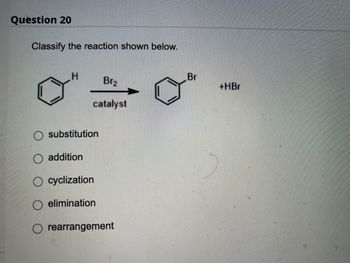
Chemistry
10th Edition
ISBN: 9781305957404
Author: Steven S. Zumdahl, Susan A. Zumdahl, Donald J. DeCoste
Publisher: Cengage Learning
expand_more
expand_more
format_list_bulleted
Question

Transcribed Image Text:Question 20
Classify the reaction shown below.
H
Br₂
catalyst
substitution
addition
O cyclization
elimination
rearrangement
Br
+HBr
Expert Solution
This question has been solved!
Explore an expertly crafted, step-by-step solution for a thorough understanding of key concepts.
Step by stepSolved in 2 steps with 2 images

Knowledge Booster
Learn more about
Need a deep-dive on the concept behind this application? Look no further. Learn more about this topic, chemistry and related others by exploring similar questions and additional content below.Similar questions
- QUESTION 2 Answer the question below the reaction. O + Excess NH4C1 +H₂O In the second step of the reaction mechanism, which of the following is formed? CH3 CI H₂C O CI H₂C O OH H₂C CH3 H₂C CH3 U 34 CH3 CH3 CH3 CH3 H₂SO4 CH3 CIarrow_forwardHow to solve the productarrow_forwardOrganic Chemistry Question PLEASE SHOW STEP BY STEP, WITH ARROWS! ALSO PLEASE INCLUDE ALL ELECTRON LONE PAIRS AND CHARGES FOR STRUCTURES IF NECESSARY!arrow_forward
- Use tge starting material to create the end product.arrow_forward3. Reactions H3C OH [0] CH3 H3C OH H2 .C. CH CH [0] H2C CH3 H2C-CH2 CH3 CH HO H,SO4 H2C CH H2C-CH2arrow_forwardH₂N. Structure 1 ОН H₂N .OH Structure 2 HaN. Reaction Bank: Reaction A: 'N' لز (H3CC" Reaction B: DCCD, HCI Reaction C: CF3CO2H ہ C(CH3)3 OHarrow_forward
- II. Draw the structure of the main product of the following reactions.arrow_forwardQuestion 5 Refer to reaction sequence below then answer the following question: oxidation CH₂OH oxidtion In the above reaction scheme, methanol is oxidized to: O formic acid O methanol O ethanol O hydrogen O formaldehydearrow_forwardDrew the mechanismarrow_forward
- How can we make the following?arrow_forwardClassify each reaction as addition, elimination, substitution, rearrangement, OH oxidation, or reduction CH3-CH₂-C-CH3 CH3 H₂SO4 addition O reduction O rearrangement oxidation substitution O eliminationarrow_forward11. Draw the structure for the molecule that would yield the products shown below under the indicated reaction conditions. Br 1 molar eq HBr -78 °C 1 molar eq HBr 50 °C Brarrow_forward
arrow_back_ios
SEE MORE QUESTIONS
arrow_forward_ios
Recommended textbooks for you
 ChemistryChemistryISBN:9781305957404Author:Steven S. Zumdahl, Susan A. Zumdahl, Donald J. DeCostePublisher:Cengage Learning
ChemistryChemistryISBN:9781305957404Author:Steven S. Zumdahl, Susan A. Zumdahl, Donald J. DeCostePublisher:Cengage Learning ChemistryChemistryISBN:9781259911156Author:Raymond Chang Dr., Jason Overby ProfessorPublisher:McGraw-Hill Education
ChemistryChemistryISBN:9781259911156Author:Raymond Chang Dr., Jason Overby ProfessorPublisher:McGraw-Hill Education Principles of Instrumental AnalysisChemistryISBN:9781305577213Author:Douglas A. Skoog, F. James Holler, Stanley R. CrouchPublisher:Cengage Learning
Principles of Instrumental AnalysisChemistryISBN:9781305577213Author:Douglas A. Skoog, F. James Holler, Stanley R. CrouchPublisher:Cengage Learning Organic ChemistryChemistryISBN:9780078021558Author:Janice Gorzynski Smith Dr.Publisher:McGraw-Hill Education
Organic ChemistryChemistryISBN:9780078021558Author:Janice Gorzynski Smith Dr.Publisher:McGraw-Hill Education Chemistry: Principles and ReactionsChemistryISBN:9781305079373Author:William L. Masterton, Cecile N. HurleyPublisher:Cengage Learning
Chemistry: Principles and ReactionsChemistryISBN:9781305079373Author:William L. Masterton, Cecile N. HurleyPublisher:Cengage Learning Elementary Principles of Chemical Processes, Bind...ChemistryISBN:9781118431221Author:Richard M. Felder, Ronald W. Rousseau, Lisa G. BullardPublisher:WILEY
Elementary Principles of Chemical Processes, Bind...ChemistryISBN:9781118431221Author:Richard M. Felder, Ronald W. Rousseau, Lisa G. BullardPublisher:WILEY

Chemistry
Chemistry
ISBN:9781305957404
Author:Steven S. Zumdahl, Susan A. Zumdahl, Donald J. DeCoste
Publisher:Cengage Learning

Chemistry
Chemistry
ISBN:9781259911156
Author:Raymond Chang Dr., Jason Overby Professor
Publisher:McGraw-Hill Education

Principles of Instrumental Analysis
Chemistry
ISBN:9781305577213
Author:Douglas A. Skoog, F. James Holler, Stanley R. Crouch
Publisher:Cengage Learning

Organic Chemistry
Chemistry
ISBN:9780078021558
Author:Janice Gorzynski Smith Dr.
Publisher:McGraw-Hill Education

Chemistry: Principles and Reactions
Chemistry
ISBN:9781305079373
Author:William L. Masterton, Cecile N. Hurley
Publisher:Cengage Learning

Elementary Principles of Chemical Processes, Bind...
Chemistry
ISBN:9781118431221
Author:Richard M. Felder, Ronald W. Rousseau, Lisa G. Bullard
Publisher:WILEY